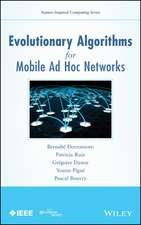Space-Time Block Coding for Wireless Communications
Autor Erik G. Larsson, Petre Stoicaen Limba Engleză Hardback – 7 mai 2003
| Toate formatele și edițiile | Preț | Express |
|---|---|---|
| Paperback (1) | 631.44 lei 43-57 zile | |
| Cambridge University Press – 11 iun 2008 | 631.44 lei 43-57 zile | |
| Hardback (1) | 712.79 lei 43-57 zile | |
| Cambridge University Press – 7 mai 2003 | 712.79 lei 43-57 zile |
Preț: 712.79 lei
Preț vechi: 828.83 lei
-14% Nou
Puncte Express: 1069
Preț estimativ în valută:
136.44€ • 148.25$ • 114.68£
136.44€ • 148.25$ • 114.68£
Carte tipărită la comandă
Livrare economică 21 aprilie-05 mai
Preluare comenzi: 021 569.72.76
Specificații
ISBN-13: 9780521824569
ISBN-10: 0521824567
Pagini: 302
Ilustrații: 2 tables 71 exercises
Dimensiuni: 180 x 254 x 26 mm
Greutate: 0.79 kg
Ediția:New.
Editura: Cambridge University Press
Colecția Cambridge University Press
Locul publicării:Cambridge, United Kingdom
ISBN-10: 0521824567
Pagini: 302
Ilustrații: 2 tables 71 exercises
Dimensiuni: 180 x 254 x 26 mm
Greutate: 0.79 kg
Ediția:New.
Editura: Cambridge University Press
Colecția Cambridge University Press
Locul publicării:Cambridge, United Kingdom
Cuprins
1. Introduction; 2. The time-invariant linear MIMO channel; 3. MIMO information theory; 4. Error probability analysis; 5. Receive diversity; 6. Transmit diversity and space-time coding; 7. Linear STBC for flat fading channels; 8. Linear STBC for frequency-selective channels; 9. Coherent and non-coherent receivers; 10. Space-time coding for informed transmitters; 11. Space-time coding in a multiuser environment; Appendices.
Recenzii
"This book will be useful for graduate students, researchers, and engineers working on wireless communications." Mathematical Reviews
Notă biografică
Descriere
This 2003 book provides detailed coverage of a technology that is embedded in the UMTS and WCDMA mobile standards.










